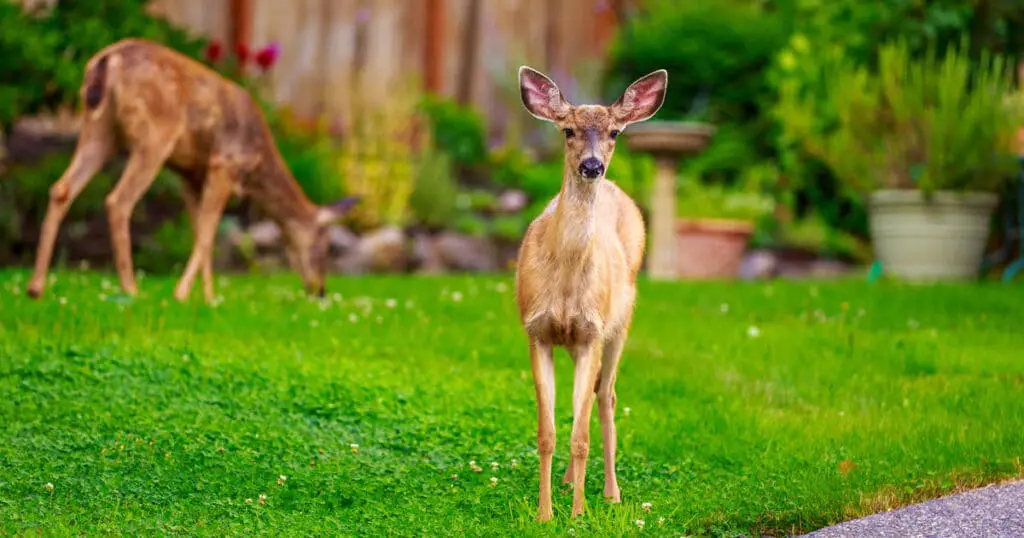If you love wildlife, maybe you’ve thought about feeding deer in your backyard. Generally speaking, you shouldn’t feed wildlife. And if you do, you must ensure you’re only offering foods that they can safely eat. In other words, only give deer food that is a natural part of their diet, avoiding foods that harm their health. So what should you feed deer in your backyard? And should you feed them at all?
Good foods to feed the deer in your backyard include different grains, nuts, and vegetables. There are also food mixes specifically made for deer that you can make yourself or purchase.
Let’s discover more detailed information on the best and worst foods to feed deer that come on your property. This guide also includes a brief guide on why you probably should not feed the deer in your backyard.
Should I Feed The Deer In My Backyard?
Table of Contents
ToggleFeeding the deer in your backyard can be fun, and it may help deer out when they have trouble finding food in the winter months. However, if you’re going to feed the deer in your backyard once, you may end up feeling pressured to do it all the time.
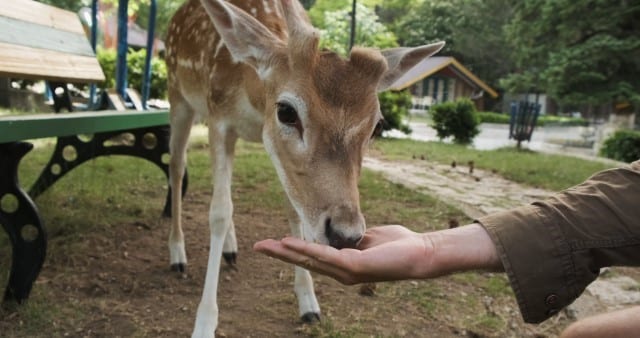
Why? Well, when deer find a good spot to find food, they’ll continue returning to that spot as long as it supplies food. They will also bring along their herd so everyone is able to eat.
So if you feed one deer, you might find an entire herd showing up on your property!
That’s why you shouldn’t start feeding deer if you don’t want these animals constantly returning to your yard for food.
Pros and Cons Of Feeding Deer in Your Backyard
Feeding deer on your property has a few pros but it has plenty of cons, as well.
Let’s start with the potential advantages of feeding deer in your backyard.
Pros of Feeding Deer in Your Backyard
The pros of feeding deer on your property include:
- Helping them find food
- Getting the chance to interact with nature
- Learning about the deer in your area
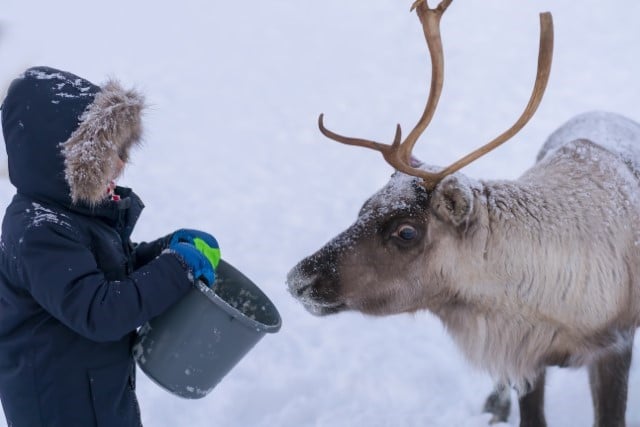
Deer are able to find food in the wild by themselves, but it doesn’t hurt to help them out once in a while. Feeding deer during the winter can be especially beneficial, as food is scarce in the winter months.
Deer are also timid creatures, so it’s rare for them to approach humans. If you feed them, then you get the opportunity to interact with them safely.
While it isn’t recommended that you get too close, you can still observe them from a safe distance by tossing them food or setting up a deer feeder.
Lastly, feeding deer in your backyard can be a very educational experience. You get the chance to learn about the diets and behaviors of the deer in your area.
Cons of Feeding Deer in Your Backyard
There are significant disadvantages to feeding deer on your property. Here they are below:
- Potential weight gain
- Diseases, which then spread to the herd
- Digesting poisonous food, resulting in death
- May attract predators
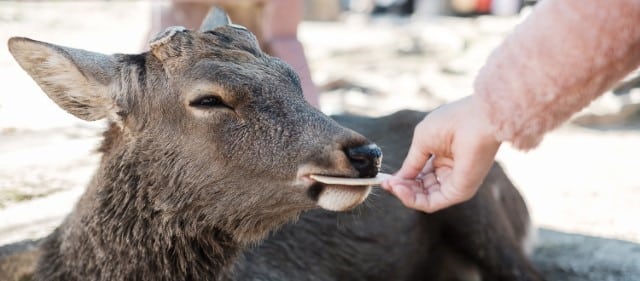
You may interfere with a deer’s diet and feeding schedule by offering it food. If you feed deer the wrong things, deer may become overweight or obese.
Another major worry is how you might attract predators, such as coyotes and bears, to your property.
Predators are then able to track a deer’s scent back to wherever you feed the deer.
What Do Deer Love To Eat The Most?
A few of the white-tailed deer’s favorite foods include:
- Browse, or young trees and shrubs
- Acorns and chestnuts
- Grains, mainly oats
- Vegetables
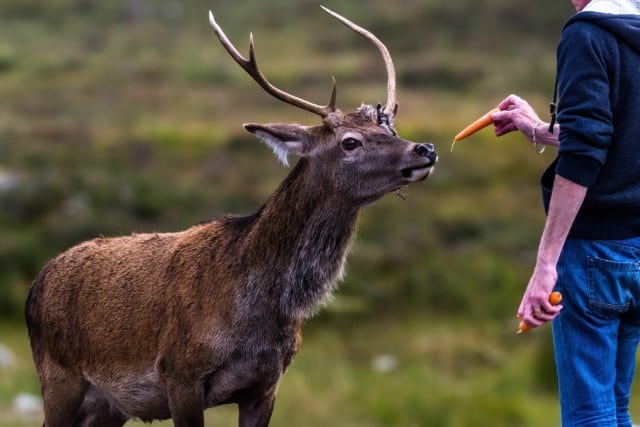
Browse refers to the stems and leaves that come from young trees. They are a great source of nutrients for the deer, especially in their first few years of life.
Acorns and chestnuts are also great sources of protein for deer.
In fact, these are the only nuts you should consider offering to these animals. Exotic nuts can upset their stomach, leading to vomiting or diarrhea.
Oats are the best grain you can give to the deer. They’re simple yet nutritious offering plenty of carbohydrates and fiber.
They’re also very inexpensive and have a long-lasting shelf life.
Lastly, vegetables are great for deer because they’re easy to digest and offer lots of nutrients. The best vegetables to feed deer include:
- Soybeans
- Black-eyed peas
- Purple hulled peas
You can find these foods at your local grocery store.
Deer Feed Mixes Are a Safe Choice
In addition to the foods mentioned above, you can also purchase deer feed mixes and pellets from most pet stores or outdoor retail stores.
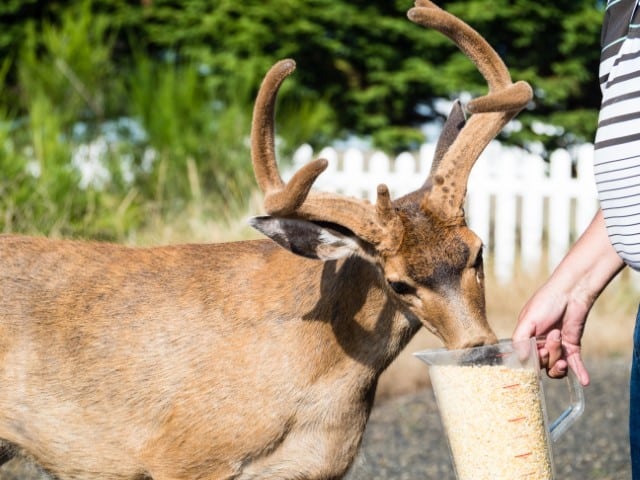
These mixes and pellets are specially designed to be fed to deer, and they include important nutrients for deer health. This makes it easier to fill up your deer feeder, offering the food mentioned above as deer treats.
Foods You Should Never Feed Deer
Foods you should never feed deer include:
- Human food
- Corn
- Hay and grass
- Meat of any kind
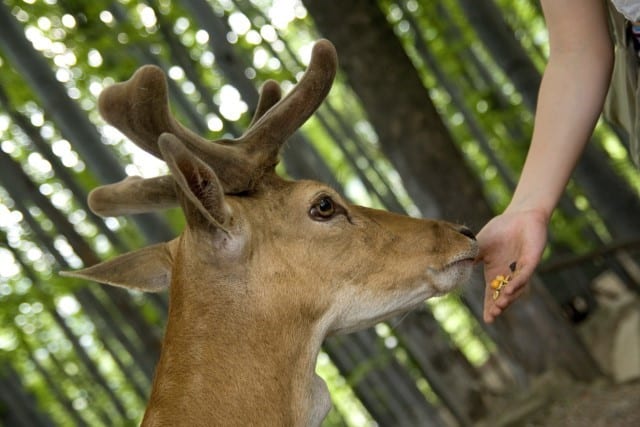
Deer aren’t able to process scrap food like livestock. They have very sensitive stomachs and won’t be able to digest human food efficiently, resulting in vomiting or diarrhea.
Never give corn to deer. It’s extremely harmful to this animal.
Corn is highly acidic, which means it can kill the microorganisms deer need to digest their food properly.
Don’t give grass and hay to deer, either. While fawns usually munch on grass or hay during their first few months of life, you should not feed these things to them.
Adult deer aren’t able to digest and pass grass properly. This can cause their stomach to get stopped up, leaving them unable to digest any food and dying from starvation.
Remember, deer are herbivores. You should never feed deer meat of any kind.
Their teeth are not strong enough to chew it, and they could end up choking.
What To Feed Backyard Deer in Spring, Summer, Fall, and Winter?
The best thing to feed deer changes at different times of the year. Their preferred diet varies by the weather and changing nutritional needs.
Spring
In the spring, a high protein diet is the best for the deer. That’s the time of year when most does will have their fawns. Having a high protein diet will help ensure the does have the necessary body mass to handle giving birth.
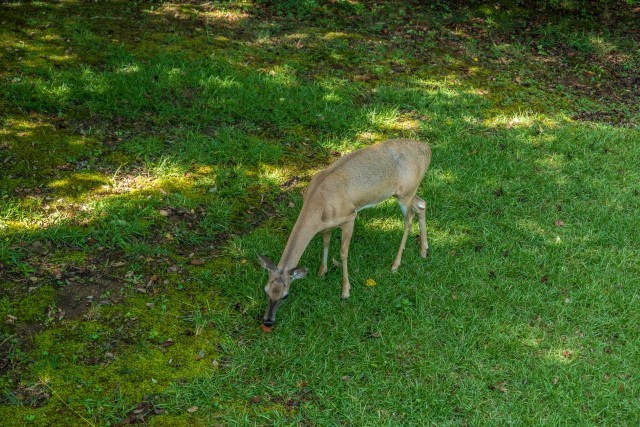
High protein pellets or increasing the number of nuts you put in your deer feeder are both great ways to offer deer more protein.
Summer
In the summer, the best thing to feed a deer is a diet high in protein and carbohydrates. Summer is when a lot of important things happen in a deer’s life, including:
- Fawn development
- Antler growth
- Fat deposition
Feeding the deer a diet full of nuts and oats will help them enjoy optimal growth and development.
Fall
The weather will start getting colder in the fall, and deer will need to rely on their fat deposits more in order to keep warm. The best thing to feed deer during the fall is plenty of browse, especially the woody stems.
This will ensure the deer get enough nutrients, without over-feeding them on protein and carbohydrates.
Winter
Finally, winter is the time of year when food is most scarce for the deer. However, this doesn’t mean you should overstock your deer feeders.
The best thing to feed deer during the winter is more woody browse and, every once in a while, some honeysuckle. Honeysuckle is very nutritious and high in protein, but too much of it can be more harmful than beneficial.
Is It Illegal to Feed Deer On Your Property?
Whether it’s illegal to feed deer on your property depends on the state you live in. Most states allow you to feed deer on your property, but not deer that live in a wildlife reserve.
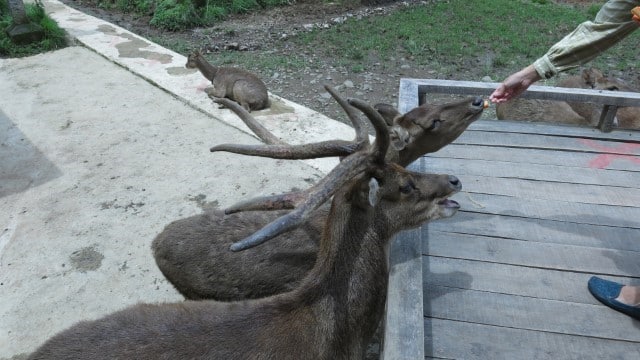
On the other hand, some states ban feeding deer altogether in order to protect the population.
If it’s illegal for you to feed deer in your backyard, you could still leave a salt or mineral lick out for them. This is a useful nutrient source for cervids.
Still Wondering What to Feed Deer in Your Backyard?
Feeding the deer in your backyard can be a pleasant way to connect with nature. It feels good to help out the wildlife in your area, especially during the colder months.
But in most cases, you’re better off not feeding the deer on your property, unless you’re setting up a food plot for hunting..
That’s because of the many disadvantages and potential pitfalls involved in making your backyard a deer feeding station. If you’re determined to do it, though, you’ve got to do it the right way.
Use the guide we’ve provided here to choose the right food to give the deer that come onto your property. The wrong kinds of food will do them more harm than good.
And of course, make sure it’s legal to feed deer in your state before setting out any food.

